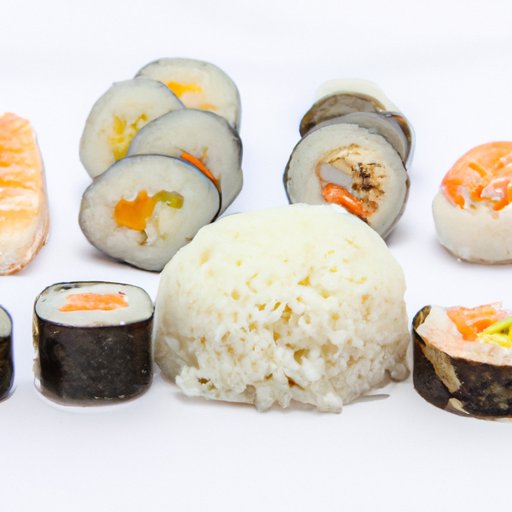I. Introduction
Are you a sushi lover who worries about eating gluten-free? You’re not alone! Nowadays, the gluten-free trend is spreading into the sushi world. Some people think sushi rice might contain gluten, and it can be challenging to navigate sushi menus when you have gluten sensitivities. In this article, we’ll explore the question, “Is sushi rice gluten-free?” and provide you with in-depth information on how to make gluten-free sushi rice and sushi rolls and how to order gluten-free sushi in restaurants.
II. Sushi Rice and Gluten: What You Need to Know
A. Definition of gluten and its potential health impacts
Gluten is a type of protein commonly found in wheat, barley, and rye. People with celiac disease or gluten sensitivities can experience a range of symptoms, from mild discomfort to severe damage to the small intestine.
B. Relationship between sushi rice and gluten
Sushi rice is made from short-grain Japanese rice, which is naturally gluten-free. However, some sushi vinegar or seasoning sauces may contain wheat, which can lead to gluten cross-contamination.
C. The gluten-free status of sushi rice
As mentioned, sushi rice is naturally gluten-free, so it’s an excellent option for gluten-free eaters. However, it’s crucial to check the ingredients of the sushi vinegar or seasoning sauces used in sushi preparation to avoid any wheat cross-contamination.
D. Potential risks of cross-contamination
Cross-contamination can happen when gluten-free ingredients come in contact with gluten-containing ingredients or surfaces. In sushi-making, cross-contamination risks arise when sushi rice comes into contact with wheat-based sauces or utensils previously used to prepare gluten-containing foods.
III. Gluten-Free Sushi Rice Recipes You’ll Love
A. Introduction of gluten-free sushi recipes
Making gluten-free sushi at home can be an enjoyable and satisfying experience, and it’s a great way to ensure that your food is entirely gluten-free.
B. Preparation of gluten-free sushi rice
To prepare gluten-free sushi rice, use short-grain Japanese rice and vinegar or seasoning sauces that are gluten-free. You can try using rice vinegar, mirin, or sake instead of typical vinegar seasoning sauces.
C. Gluten-free sushi roll recipes
There are various sushi roll recipes you can make using gluten-free ingredients. You can try making California rolls with crab meat, avocado, and cucumber, or spicy tuna rolls with tuna and mayonnaise mixed with chili flakes.
D. Explanation of modification techniques
If you’re a sushi lover who can’t eat gluten, don’t worry. You can modify sushi recipes to suit your dietary needs by avoiding gluten-containing ingredients and cross-contamination risks.
IV. The Ultimate Guide to Gluten-Free Sushi Making
A. Selection of gluten-free ingredients for sushi preparation
The key to preparing gluten-free sushi is choosing gluten-free ingredients. Besides gluten-free rice vinegar and seasoning sauces, you can use gluten-free fillings like salmon, tuna, shrimp, or vegetables.
B. Rolling techniques
Making sushi rolls requires practice, but it’s rewarding. When rolling sushi, make sure your hands and equipment are entirely clean to avoid cross-contamination.
C. Alternatives to soy sauce
Soy sauce often contains gluten, so it’s essential to use gluten-free alternatives like tamari or coconut aminos.
D. Tips for preventing cross-contamination
To avoid cross-contamination, make sure to use separate equipment for gluten-containing ingredients and gluten-free ingredients. Clean all utensils and surfaces thoroughly before use.
V. Sushi Rice Brands: Which Ones are Gluten-Free?
A. Investigation into different sushi rice brands
There are many different sushi rice brands on the market. However, not all brands are gluten-free, so it’s essential to choose a brand that is certified gluten-free.
B. Gluten-free status of popular brands
Popular gluten-free sushi rice brands include Tamanishiki, Nishiki, and Botan. Always check the label before purchasing, and if in doubt, contact the manufacturer to confirm gluten-free status.
C. Gluten-free sushi rice brand recommendations
We recommend Tamanishiki sushi rice for its high-quality, consistent texture, and gluten-free certification.
VI. The Gluten-Free Sushi Trend: What’s Behind It?
A. Explanation of the trend
The gluten-free trend is sweeping the world, and sushi is no exception. Many people have celiac disease or gluten sensitivities and prefer to follow a gluten-free diet.
B. Reasons for the rising popularity of gluten-free sushi
Gluten-free sushi has become popular, not only due to the prevalence of gluten sensitivities but also a general trend toward healthy, sustainable diets. Additionally, some people prefer the taste of gluten-free sushi rice.
C. Consequences for the future of sushi-making
As more people embrace gluten-free diets, sushi restaurants and chefs may need to adjust their menus to cater to this growing trend.
VII. Sushi Rice vs. Other Sushi Fillers: Which Is More Likely to Contain Gluten?
A. Comparison of the risks of cross-contamination
While sushi rice is naturally gluten-free, other popular sushi fillings like imitation crab meat, tempura batter, and soy sauce often contain gluten.
B. Differences in risk between sushi rice and popular sushi fillings
The risk of cross-contamination is higher with gluten-filled sushi fillings than with sushi rice, so it’s crucial to be vigilant when ordering sushi in restaurants.
C. Safe gluten-free sushi filling alternatives
Safe gluten-free sushi filling alternatives include fresh fish, avocado, cucumber, carrots, and other vegetables.
VIII. Expert Advice: How to Order Gluten-Free Sushi in Restaurants
A. Tips and tricks for navigating sushi menus
When ordering sushi in restaurants, be upfront with your dietary needs. Ask your server or the chef which ingredients contain gluten and which dishes are safe for you to eat.
B. Guidance from professional sushi chefs
Professional sushi chefs can advise you on gluten-free sushi options and provide insights into how dishes are prepared to minimize cross-contamination risks.
IX. Conclusion
A. Recap of topics covered
In this article, we explored the question, “Is sushi rice gluten-free?” and provided information on how to make gluten-free sushi rice, sushi rolls, and order gluten-free sushi in restaurants.
B. Final thoughts on gluten-free sushi rice
Sushi rice is naturally gluten-free, and with careful ingredient selection and preparation techniques, you can enjoy gluten-free sushi at home and in restaurants.
C. Encouragement to experiment with gluten-free sushi-making
Experiment with gluten-free sushi-making at home by trying new ingredients and rolling techniques.
